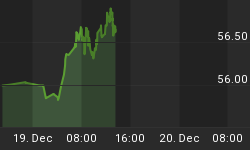Last week I was changing my tune. This week's tune is the same old song: "Equities are for renting not owning at this juncture. I am not calling for a market top, but prices should trade more in a range, and if you intend to play on the long side, it will be important to maintain your discipline (for risk reasons) and buy at the lows of that trading range and sell at the highs to extract any profits from this market. The upward bias still remains as long as investor sentiment is still extremely bullish, but there is probably greater risk of a market down draft now than in past weeks."
As the only real change to the data is the increased number of Rydex market timers who are bullish and leveraged, I thought it would be a good time to look at how long the "Dumb Money"indicator could go between bullish signals (i.e, investors are bearish). The "Dumb Money" indicator, which is shown in figure 1, looks for extremes in the data from 4 different groups of investors who historically have been wrong on the market: 1) Investor Intelligence; 2) Market Vane; 3) American Association of Individual Investors; and 4) the put call ratio. The "Dumb Money" indicator shows that investors are extremely bullish.
Figure 1. "Dumb Money" Indicator/ weekly
Referring to the "Dumb Money" indicator in figure 1, bullish signals occur when investors are bearish or when the indicator is green in color. So what we want to know is the average time spent between bullish signals. Since 1990, this number is 18 weeks. In the current price cycle, prices bottomed in March, 2009 and we have continued higher for 29 straight weeks. That is, the last bullish signal (or the last time the indicator was green) was 29 weeks ago.
While the current price run has gone on for 11 weeks longer than average, there have been several longer price runs over the past 19 years. The longest started in October, 1994 and lasted 91 weeks. The second longest started March, 2003 and lasted for 60 weeks; in many respects the current rally and economic environment most resembles (i.e., think ultra low Fed Funds rate and Dollar devaluation) seen in the last bull market. The third longest time between bull signals ran for 49 weeks and started in November, 1998.
The current price cycle has been extraordinary in price but not in time. It is likely that the next bull signal (i.e., when investors are bearish) will be weeks away as it takes the bullish extremes of the current market environment to be unwound.
The "Smart Money" indicator is shown in figure 2. The "smart money" indicator is a composite of the following data: 1) public to specialist short ratio; 2) specialist short to total short ratio; 3) SP100 option traders. The "smart money" is neutral.
Figure 2. "Smart Money" Indicator/ weekly
Company insiders continue to sell shares to an extreme degree. See figure 3, a weekly chart of the S&P500 with the Insider Score "entire market" value in the lower panel. From the InsiderScore report: "Selling was still in favor during a light week".
Figure 3. InsiderScore Entire Market/ weekly
Figure 4 is a daily chart of the S&P500 with the amount of assets in the Rydex bullish and leveraged funds versus the amount of assets in the leveraged and bearish funds. Not only do we get to see what direction these market timers think the market will go, but we also get to see how much conviction (i.e., leverage) they have in their beliefs. Typically, we want to bet against the Rydex market timer even though they only represent a small sample of the overall market. As of Friday's close, the assets in the bullish and leveraged funds were greater than the bearish and leveraged by 1.77 to 1; referring to figure 4, this would put the green line greater than red line. When this ratio is greater than 2 the rally has generally stalled as noted by the maroon vertical lines.
Figure 4. Rydex Bullish and Leveraged v. Bearish and Leveraged/ daily















